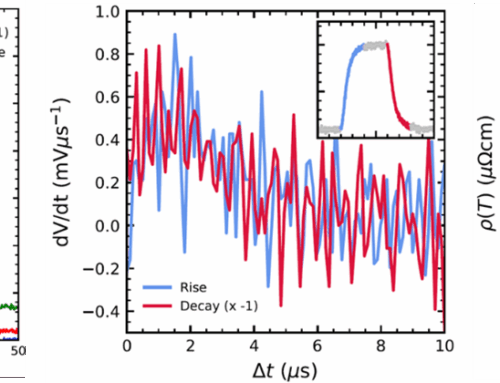Adrien Rosuel, Christophe Marcenat, Georg Knebel, Jean-Pascal Brison, Phéliqs Grenoble, Thierry Klein, Institut Néel, Grenoble, Dai Aoki, Tohoku University, Albin Demuer, and Gabriel Seyfarth, LNCMI-Grenoble.
The discovery that superconductivity can also be induced by direct interactions between electrons, for example mediated by their magnetic properties, was a real breakthrough. However, a precise identification of this pairing mechanism remains a major challenge. In high-Tc cuprates, for example, still no consensus exists on which interactions control the formation of the Cooper pairs. Recently, we have shown in a collaboration of Phéliqs, Néel Institute, the LNCMI Grenoble, and Tohoku University that the strongly correlated system, UTe2, is the first one, for which two different pairing mechanisms can lead to different superconducting (sc) states. Moreover, a magnetic field can tune, which mechanism will drive the sc state. The team discovered that the anomaly, i.e., the specific-heat jump, which marks the transition between the normal and the sc state, broadens more than 4 times in the field-reinforced state. This is unique: in the very few other examples of superconductors displaying multiple sc phases, the sc states differ only by a change of symmetry, and in such a case, there is no remarkable change of the specificheat anomaly. Here, in UTe2 it is likely that the low-field spin-triplet sc phase is driven by ferromagnetic fluctuations, whereas the highfield phase with a broad specific-heat anomaly emerges from other magnetic fluctuations developing under magnetic field. A peculiarity of the phase diagram of UTe2 (figure) is that the fieldreinforced sc state abruptly disappears above 35 T, coinciding with a first-order metamagnetic transition. The mentioned “other” magnetic fluctuations are most likely related to the emergence of the metamagnetic transition. Detailed analysis shows that a pairing mechanism controlled by the metamagnetic field could explain quantitatively the strong broadening of the specific-heat anomaly, as well as its high sensitivity to a small misalignment of the field from the b axis. However, surprisingly, the high-field phase, contrary to the low-field one, would be spin singlet. This is counter-intuitive: a spin-singlet state for the Cooper pairs is usually detrimental for superconductivity at high magnetic field, because of the loss of magnetic energy due to the alignment of spins in the field. At the opposite, a triplet state allows to form Cooper pairs with spins polarized along the applied magnetic field; hence, it should be favored at high fields. Nevertheless, this additional twist is consistent with some theoretical predictions studying precisely the competition of different pairing mechanisms in this system under pressure, where several sc phases have also been discovered.

Figure 1: Two different superconducting phases in UTe2 as observed by thermodynamic specific-heat measurements, showing the transition line between the two phases. At the bottom, the change of the specific-heat anomaly, becoming very broad in the high-field phase is very clear: note the curve at 18 T, where both anomalies are successively observed.
Field-Induced Tuning of the Pairing State in a Superconductor, A. Rosuel, C. Marcenat, G. Knebel, T. Klein, A. Pourret, N. Marquardt, Q. Niu, S. Rousseau, A. Demuer, G. Seyfarth, G. Lapertot, D. Aoki, D. Braithwaite, J. Flouquet, and J.P. Brison, Phys. Rev. X 13, 011022 (2023).
https://journals.aps.org/prx/abstract/10.1103/PhysRevX.13.011022
Contact: gabriel.seyfarth@lncmi.cnrs.fr






